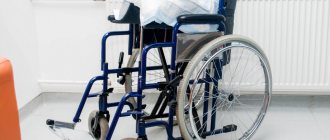The Expanded Disability Status Scale (EDSS) is a rating system that is often used to standardize and quantify the conditions of patients with multiple sclerosis (MS).
Although it is difficult to use and understand, I think it is important that people diagnosed with MS have a basic understanding of what the scale is and how it is used. Moreover, EDSS is an important tool in clinical research: it determines the possibility of patient inclusion in the study, and it also helps to quantify the results of the study.
Thus, the disability scale will allow you to interpret the results of clinical studies, which, as a rule, contain the following records: “the average disability scale score at the beginning of the study was 3.5 on the EDSS scale, after two years from the start of the study the EDSS score was on average increased by 1.5 points.”
Calculation of EDSS scores
Assessment of the patient's condition is based on the results of a neurological examination and study of the functional systems (FS) of the central nervous system. Functional systems are:
- Pyramid (responsible for the ability to walk)
- Cerebellum (responsible for coordination)
- Brain stem (speech and swallowing)
- Sensory
- Visual
- Bowel and bladder
- Mental
- Other (includes any other neurological impairment acquired as a result of MS, including fatigue)
Expanded Disability Scale (EDSS)
edss scale for multiple sclerosis
0.0: Neurological examination results are normal.
1.0: There is no disability, but there are minimal signs of impairment in one of the functional systems (FS) (for example, vibration sensitivity is weakened).
1.5: There is no disability, but there are minimal signs of impairment in more than one of the functional systems (FS).
2.0: There are signs of minimal disability in one of the FS (for example, slightly impaired gait).
2.5: There is “mild” disability in one of the FS or minimal disability in two FS.
3.0: Moderate disability in one of the FS or “mild” disability in three or four FS. However, the patient is still completely ambulatory.
3.5: The patient is outpatient, but there is moderate disability in one of the FSs and “mild” disability in one or two FSs; or moderate disability in two FS; or “mild” disability in five FS.
4.0: The patient is ambulatory, spends most of the day (12 hours) on his feet without assistance, despite a relatively severe disability. He is able to walk 500 meters without assistance or rest.
4.5: The patient is an outpatient and spends most of the day on his feet without assistance. He is able to work full time, but with some limitations or requires minimal assistance. Can walk 300 meters without assistance.
5.0: The patient is able to walk 200 meters without assistance or rest. Disability worsens the patient's quality of life; he needs part-time work.
5.5: The patient is able to walk 100 meters without assistance or rest. Disability does not exclude full daily activities.
6.0: The patient requires intermittent or continuous unilateral support (cane) to walk 100 meters with or without rest.
6.5: The patient requires constant bilateral support (cane, crutches or walker) to walk 20 meters without resting.
7.0: The patient is unable to walk more than five meters even with assistance and is essentially confined to a wheelchair. However, he moves independently in a wheelchair and is active about 12 hours a day.
7.5: The patient is unable to take more than a few steps and is limited to a wheelchair; the patient requires assistance to move in the wheelchair.
8.0: The patient is confined to a bed, chair, or wheelchair, and may be in bed most of the day. He retains the ability to self-care.
8.5: The patient spends most of the day in bed but has difficulty caring for himself.
9.0: Patient is bedridden but still able to communicate and eat.
9.5: The patient is completely helpless and bedridden. He is unable to communicate, eat or swallow.
10.0: Death due to multiple sclerosis.
EDSS scale. Assessment of manifestations of multiple sclerosis
With all the variety of symptoms of multiple sclerosis, an objective assessment of the clinical status of patients is mandatory. For these purposes, the Expanded Disability Status Scale (EDSS) . EDSS allows you to track changes in disability status over time. The scale is widely used in clinical research and assessment of patients with multiple sclerosis [1, 2].
The EDSS method was developed by neurologist John Kurtzke in 1983 [2].
The Kurtzke assessment allows you to:
- objectively assess the clinical manifestations of the disease;
- prescribe certain medications;
- predict the further course of the disease;
- determine the priority of choosing certain therapeutic strategies.
This scale evaluates the severity of symptoms in points from 0 to 10 in increments of 0.5 units [2].
An EDSS score of 1.0 to 4.5 corresponds to patients being able to move and care for themselves independently. It is made based on an assessment of various functional systems of the body [2]:
- pyramidal - weakness or difficulty moving the limbs;
- cerebellar - coordination problems, tremor;
- brainstem - speech disorders, swallowing and nystagmus;
- sensory - numbness, loss of sensitivity;
- bladder and intestines;
- change in intellectual abilities - thinking;
- visual.
Grades from 5 to 8 are assessed based on motor abilities [2].
| EDSS |
| 1.0 - no violations 1.5 - no violations |
| 2.0 - minimal impairment, outpatient 2.5 - mild impairment, outpatient |
| 3.0 - moderate impairment, outpatient 3.5 - moderate impairment, outpatient |
| 4.0 - relatively severe weakness, can be in an upright position for up to 12 hours a day, fully cares for oneself, can walk 500 m without assistance and rest 4.5 - requires minimal assistance, can work full day, walk 300 m without assistance and rest |
| 5.0 - can walk 200 m without assistance and rest, it is difficult to work full time 5.5 - can walk 100 m without assistance and rest, cannot work full time |
| 6.0 - unilateral support for walking a distance of 100 m 6.5 - constant support on 2 sides for walking 20 m without rest |
| 7.0 - cannot walk 5 m with assistance, but can move in a wheelchair all day 7.5 - needs assistance in moving in a wheelchair, cannot stay in it all day |
| 8.0 - limited to bed or chair, self-care with hands 8.5 - limited to bed or chair, uses hands effectively, but has difficulty self-care |
| 9.0 - bedridden, requires constant care, communication and eating are possible 9.5 - helpless, speech and swallowing are impaired. |
When the clinical picture worsens, an increase in the EDSS scale by 0.5-1 points is most often noted, while a decrease in EDSS by one point means an improvement in the condition or stabilization of the process [2].
In practice, the EDSS scale is used to select the optimal treatment tactics for DMTs (a group of drugs that modify the course of multiple sclerosis) [1].
DMT drugs are prescribed to patients whose EDSS score does not exceed 6.5.
Interesting fact
Most people with multiple sclerosis do not progress to high levels of disability.
There is a misconception among patients and some doctors that the disease will inevitably lead to severe disability in the near future after diagnosis, but this view of the prognosis of MS is not correct. If treatment is started promptly, most patients with MS are able to ambulate independently without assistance and may have minimal neurological deficits. Many patients with MS remain able to work throughout their lives and become disabled only temporarily, during the period of exacerbation of the disease [3, 4].
The use of the EDSS disability scale allows one to assess the degree of damage to various functional systems of the body and select appropriate therapy individually for each patient [5]. This helps to delay or avoid the disability of a patient with multiple sclerosis.
Disadvantages of using the EDSS scale to assess the condition of patients with MS
Researchers and experts note the following shortcomings of EDSS as a system for quantitatively assessing the condition of patients with multiple sclerosis, the progression of their disease and the effectiveness of the therapy used:
- EDSS places too much emphasis on walking ability.
- It is insensitive to cognitive dysfunction in people with MS (as are most scores based on standard neurological examinations).
- Calculating the EDSS score is complex because the rules by which neurological examination results are translated into functional system scores are ambiguous.
- The scale is not sensitive to changes in the clinical picture in patients with a long duration of the disease.
- In practice, it is not uncommon for patients to “jump” from one part of the scale to another over time, rather than demonstrating a smooth decline (this point is especially important when assessing the effectiveness of long-term use of medications).
It is important to remember that the EDSS score can vary significantly. For example, a patient with sensory impairment for a sufficiently long period of time will have an EDSS score of 1.0. An exacerbation with symptoms of optic neuritis can raise this score to 3.0. After treatment (or independent regression of symptoms), the score may return to 1.0 (or 1.5 if there were several such exacerbations).
Most neurologists do not formally use the EDSS when monitoring patients, but some neurologists make rough estimates of disability to determine the appropriateness of certain prescriptions (eg, corticosteroid therapy).
Source: Kurtzke, Neurology, 1983
Used to quantify disability in multiple sclerosis. The EDSS replaced the earlier Disability Disability Scale, which was used to categorize patients with multiple sclerosis into lower categories.
The EDSS scale allows neurologists to quantify the degree of disability across 8 functional systems (FS) and assign each of these systems its own score. Functional systems include:
- Pyramid
- Cerebellar
- Brain stem
- Sensory
- Functions of the pelvic organs
- Visual
- Brain (cortical - mental functions)
- Other
EDSS scores from 1.0 to 4.5 refer to patients with multiple sclerosis in whom mobility is fully preserved, while scores from 5.0 to 9.5 refer to patients with impaired mobility.
| 0,0 | No pathology is detected during neurological examination |
| 1,0 | No impairment of vital functions, minimal signs of damage to one FS |
| 1,5 | No impairment of vital functions, minimal signs of damage to more than one FS |
| 2,0 | Minimal disability in one FS |
| 2,5 | Mild impairment in one FS or minimal impairment in two FS |
| 3,0 | Moderate impairment of vital functions in one FS or mild impairment in 3–4 FS. Mobility is completely preserved. |
| 3,5 | Mobility is completely preserved, but there are moderate impairments in one FS and more than minimal impairments in several other FSs |
| 4,0 | Mobility is completely preserved, mobility aids are not required, self-care is preserved, the patient is “on his feet” for more than 12 hours a day, despite relatively severe impairments; can walk about 500 m without aids or rest. |
| 4,5 | Mobility is fully preserved, no mobility aids are required, the patient is on his feet most of the day, can work full time, but overall activity level is reduced or minimal assistance may be required; relatively severe disability; can walk about 300 m without aids or rest. |
| 5,0 | Can walk about 200 m without aids or rest; disability is so severe that the patient cannot maintain full activity throughout the day (for example, cannot work full time without special conditions) |
| 5,5 | Can walk without aids or rest for about 100 m; disability is so severe that the patient is unable to be active throughout the day |
| 6,0 | To overcome 100 m with or without rest, periodic or constant unilateral use of aids (cane, crutch) is necessary. |
| 6,5 | To overcome 20 m without rest, constant bilateral use of aids (cane, crutch) is necessary. |
| 7,0 | Unable to walk more than 5 m, even with the use of assistive devices, moves mainly in a wheelchair; operates a standard wheelchair independently, moves alone; can be in a wheelchair for 12 hours a day |
| 7,5 | Unable to take more than a few steps; moves in a wheelchair; may require assistance to move around in a wheelchair; unable to use a standard wheelchair all day; may require a motorized wheelchair |
| 8,0 | Mostly confined to a bed or a wheelchair, or uses a wheelchair; can independently spend most of the day out of bed; many self-service functions are retained; usually uses hands effectively |
| 8,5 | Mainly bedridden most of the day; Uses hands quite effectively, some self-service functions are retained |
| 9,0 | Completely bedridden; can communicate and eat |
| 9,5 | Absolutely helpless and bedridden; unable to communicate effectively or eat/swallow |
| 10,0 | Death due to multiple sclerosis |
Materials on cardiology and neurology: https://www.cardioneurology.ru/edss/









